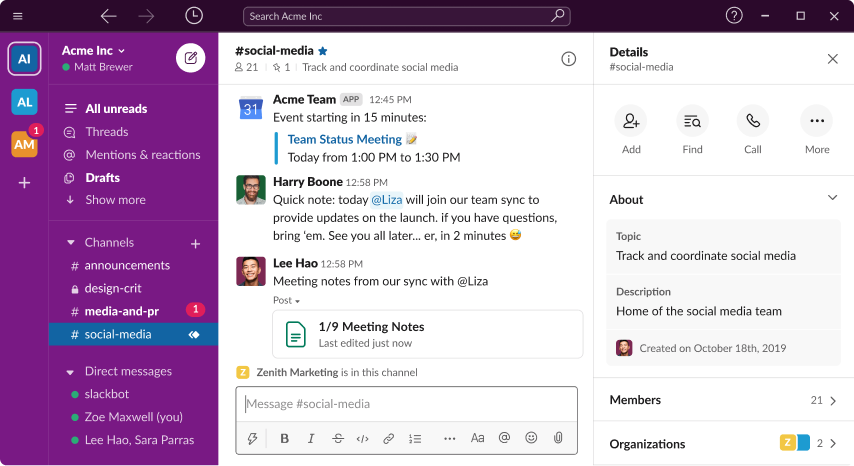Today, one of the most significant factors in business growth is technology. Many companies are actively thinking about how to increase their current and future investments in technology-based business tools in order to make their operations more efficient.
Running a business is a hard path to take, and entrepreneurs need to be aware of the challenges along the way. It’s therefore important to acquire the necessary tools you’ll need to overcome any obstacles.
Here’s a look at some of the areas where tools can be beneficial for all businesses.
How Tools Are Transforming Business
Appropriate use of tools powers businesses with competitive advantage by pushing up productivity of the micro processes involved. Hence, optimum efficiency in every process is of utmost necessity, and monitoring, evaluating, and streamlining these processes is the most difficult task.
Here is where tools can save your day.
1. Tools for Communication & Collaboration
Effective communication is important both within and outside the organization. Communication tools enable faster, more widespread, and efficient communication within your team as well as interactions with clients, potential customers, investors, and the general public.
Many businesses are using Skype, Google Meet, and other video conferencing tools for seamless communication and collaboration. Top on the list is Google Meet which allows users to conduct video conferences with a large number of participants- up to 100 participants for free and up to 250 participants for its G Suite users.

What’s great about Google Meet is its intuitive screen sharing feature that makes it easy to present documents, brainstorm, and collaborate on projects even with a remote team.
There are some cool features that you can try out. For example, on pressing the “CC” button at the bottom of the Google Meet call screen, the video will automatically generate transcriptions of what each participant is saying. Since Google Meet supports multiple languages, the “CC ” feature is perfect for your multi-lingual colleagues around the world. These features make meetings more convenient. During calls, users can also use a tool known as “Whiteboarding,” or “Jamboard” which allows them to actively brainstorm with other participants.
Skype, on the other hand, allows more flexibility to users to send instant text messages, images, and files to individuals or teams. Other than offering video and audio calls to individuals/ groups, Skype even offers long distance calling to mobile phones and landlines in exchange of nominal fees per month.

Skype allows users to meet for up to 4 hours at a time with its free version. You can also have a total of 100 people in a single Skype call with the free version
Other than screen sharing, both tools allow users to record calls, which can be useful for capturing important discussions or meetings.
The next step from communication is collaboration and there are tools designed specifically to make collaboration more efficient.
This is where Slack shines bright. Slack provides a platform for team collaboration, allowing users to create channels for different topics or projects, send messages, share files, and collaborate in real-time. Though it’s a paid tool, the free version is also very powerful and integrates with various third-party apps such as Google Drive, Trello, and Zoom, making it easy to connect and collaborate across different platforms.

Slack offers workflow automation tools such as Slackbot and custom workflows, allowing users to automate repetitive tasks and streamline their workflows.
The shining star in this segment is Asana. Asana provides excellent project management features which allows users to create collaborative tasks with team members, set deadlines, assign responsibilities, comment on updates, communicate within the platform, and track progress – making it easy to work together on projects. Asana offers a calendar view that allows users to visualize tasks and deadlines in a calendar format, making it easier to manage schedules.

Asana also integrates with various third-party apps such as Google Drive, Slack, and Microsoft Teams, enabling users to connect and collaborate across different tools.
2. Tools for Process Documentation
Documentation is a critical aspect of process management and is essential for the effective and efficient operation of any organization. However, documentation is not a one-time activity but a continuous process that requires regular updates and revisions to reflect the current situation and best practices. It is also a collaborative effort that involves input and feedback from different team members and stakeholders. Therefore, it is important to use the right tools that enable easy creation, sharing, and editing of documentation.
Tools for process documentation work by capturing, outlining, and describing each step of a specific task in real time. These tools also allow a high degree of collaboration across multiple users and synchronization with various software platforms.
Our first pick in this segment is Notion. Notion is an all-in-one workspace for taking notes, managing knowledge, projects and tasks. It is a file management application that provides a unified workspace for users to comment on ongoing projects, participate in discussions, and provide feedback.
The tools’ minimalist and modular nature makes it super easy to work on. Businesses love to work with Notion as it has a powerful and versatile interface for creating and organizing notes, documents, and articles.

Notion also integrates with other tools, allowing users to import and export data from and to external sources.
The recent integration between Notion and ChatGPT is super exciting. You can easily use this feature by simply installing Google extensions like ‘ChatGPT to Notion’ and the powerful AI system will start working hand-to-hand with you. For instance, you can make a summary, a list of action items, a breakdown of the budget and resources allotted, a timeline for the campaign launch, and a list of any follow-up tasks are just a few of the items that Chat GPT can quickly produce from Meeting Notes. These notes can then be quickly distributed to the team via Notion, ensuring that everyone is aware of their responsibilities and is on the same page. Furthermore, ChatGPT can generate automatic reminders to team members about upcoming deadlines.
Also, there is an array of Cloud-based software, such as Google Docs, Sheets, Slides, Forms etc. that enables users to easily create and share documents. Businesses that want to develop work instructions or procedures may find it helpful.
3. Tools for Customer Relationship Management
Maintaining a healthy relationship with customers is very crucial for the survival of any business. The tedious task of managing customer relations can be done easily and more efficiently with the help of CRM tools.
A CRM replaces the numerous spreadsheets, databases, and apps that companies often slap together to track customer information. CRM clubs all these basic tools into one so that your team can access and manage customer data through a single platform. Businesses can easily track all communications and cultivate relationships with their leads, current, and potential customers with the aid of CRM tools like Hubspot.
Hubspot is an ‘all-in-one’ solution for your customer relationship management problem. It is a comprehensive CRM platform that offers a wide range of features for marketing, sales, customer service, and automation. It allows users to manage contacts, leads, customers, and deals in a centralized database. Users can track interactions, set reminders, and create custom properties to store relevant information about their leads. HubSpot includes features for managing customer service inquiries, tracking tickets, and providing timely support to customers. But where Hubspot really steals the show is its feature to analyse customer service metrics. HubSpot provides comprehensive reporting that provides insights regarding customer service efforts and aids optimization of strategies.
4. Tools to Power Up Marketing
Marketing tools are crucial in alleviating, automating, empowering, and optimizing the marketing endeavors of a company.
There are a number of marketing tools available, each offering various useful functions. In general, marketing tools offer valuable analytics that can help businesses make informed decisions about their marketing strategies, allowing you to customize your strategy to your target audience. Marketing tools also let businesses know their target audiences and offer easy management of updates, such as new products, features, services, awards, events etc. and feedback.
For example: If your need is to engage customers effectively and solve their queries in real time then Intercom could come in handy. Intercom assists businesses in developing strong relationships with their customers right from the first visit to becoming a loyal customer. Intercom assists businesses by increasing conversions, engagement, retention, and satisfaction. This platform helps businesses deliver personalized and relevant messages to their customers. Intercom mainly focuses on three areas: user engagement, targeted messaging, and analytics. Intercom features omnichannel support conversations, two-way messaging, AB testing, AI/Machine Learning, API Access Controls/Permissions, and Activity Dashboard. But that’s not all, Intercom also has an all-new Inbox built to help teams resolve customer issues faster in a tool they love. Intercom can help automate processes such as routing, assignments, and SLAs which frees up your team to handle more important tasks. The customer support chatbots can be built and implemented in minutes to collect information, initiate conversations or answer FAQs.
It also sends targeted automated messages to customers and prospects based on their behavior, interests, or needs in order to prod them to take action, such as signing up, upgrading, or renewing their subscription. Intercom takes your marketing game a step further by collecting customers’ feedback and understanding how they feel about the products or services.
Another tool for you to grow your business faster and smarter is Mailchimp. It is a platform that helps you create and manage email marketing campaigns for your business. It lets you design beautiful and engaging emails, send them to your target audience, and track their performance.

You can also use Mailchimp to automate your customer journeys, segment your contacts, optimize your content with AI, and integrate with hundreds of other tools.
HubSpot also offers a suite of marketing automation tools that enable users to create, automate, and analyze marketing campaigns. This includes email marketing, social media scheduling, landing page creation, lead nurturing, and lead scoring. But the highlight is HubSpot’s machine learning-powered predictive scoring that parse through thousands of data points in order to identify your best leads. This can really help you streamline your marketing efforts with sales by ensuring that your sales team can concentrate on the most promising prospects.
So, it is obvious that tools can aid the growth of a business tremendously. But it’s also very easy to go down the rabbit hole in the world of tools. So, you need to use tools in a balanced manner.
Finding Balance with Business Tools
Whenever you are considering introducing a tool in your workflow, run this 4-step test to decide if the tool is right for you.

The first test is assessing the necessity. You need to check whether you really need the tool and whether that tool is likely to give you a return on your investment. Introducing a new tool requires investment in terms of money, time, and effort required to onboard your team. So, you need to ascertain whether all of that time, money, and effort will be rewarded with increased productivity.
The second test is finances. Tools are not always free – there may be subscription charges or charges to unlock premium features. Hence, decide very carefully the number and type of tools you need as per the scale and requirement of your business.
The best way is to opt for free tools or paid tools that have free versions available. Many tools provide excellent features even in free versions, so try to use them first, and only go for paid versions or premium features if those really add any value to your scaling and growth purposes.
The third test is checking dependency level on tools. Glitches, bugs, power, or server failure are inevitable, and if your business gets addicted to over-dependence on tools, then in times of such emergencies, you may find yourself unable to accomplish simple business tasks. While tools offer speed, efficiency, and better time management, it is necessary to retain a few human touch to regain control if glitches happen. So, the test is about how much human touch you are losing by employing certain tools.
The fourth test is judging the possible deficit in physical interaction due to tools. This test is meant especially for communication and collaboration tools. Communication tools are great for collaboration and keeping track of the projects, but they decrease the amount of time people spend face-to-face. Tools can hamper the growth of bonds between employees that are greatly facilitated with physical interactions. An optimum balance between communication tools and face-to-face communication is needed to maintain productivity.
Takeaway
Before choosing a tool, test it in 4 steps: need, cost, balance, and human touch. Don’t get dazzled by fancy features. Pick a tool that solves your problem, fits your budget, complements your work, and doesn’t replace your team.
That’s all we’ve got for now.
Keep visiting for more exciting insights and post your views in our comment section.






